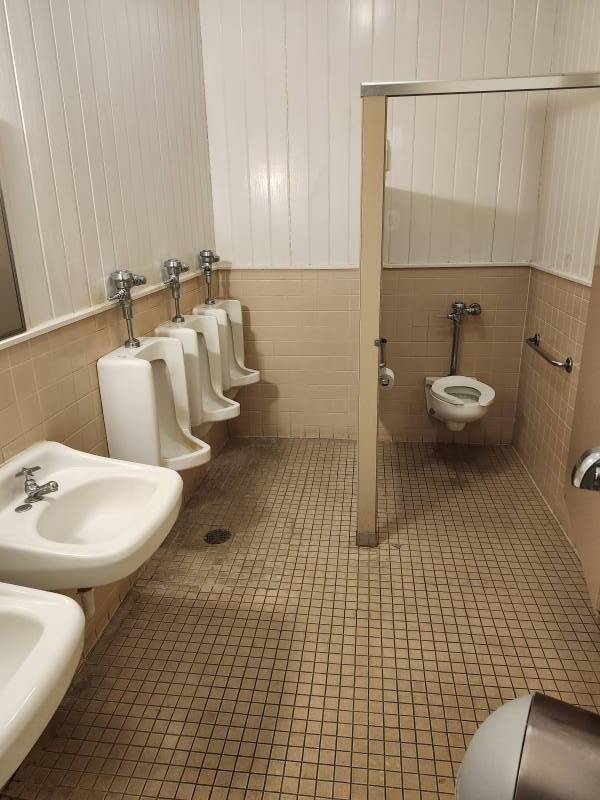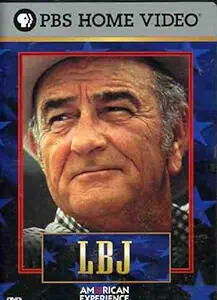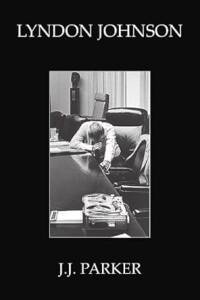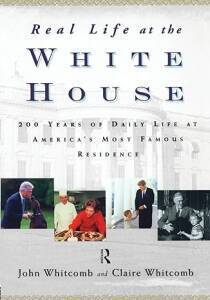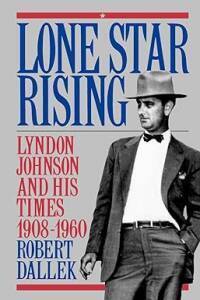
Lyndon Johnson's Chamber Pots, Outhouses, and Other Plumbing
LBJ's WCs
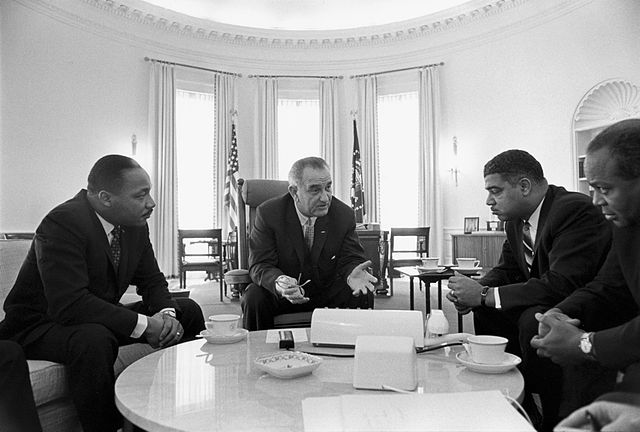
LBJ meeting with (L-R) civil rights leaders Martin Luther King Jr., Whitney Young, and James Farmer in the White House in January 1964.
Lyndon Baines Johnson
became involved in U.S. national politics in 1931.
He served in the House of Representatives 1937–1949,
active duty in the U.S. Navy 1941–1942
and remained in the Navy Reserve,
and then was in the U.S. Senate 1949–1961.
"Master of the Senate", as one biography described him.
He became Vice President of the U.S. under
John Kennedy in 1961,
and became President at Kennedy's assassination on
November 22, 1963.
He was elected President in 1964,
and served through January 20, 1969.
Johnson's birth and boyhood in rural Texas
remained a major part of his identity
throughout his life.
During his years of national service he accomplished
some great things, starting with
extending rural electrification.
As President he's known for greatly expanding civil rights,
health care, education and the arts,
environmental protection,
and both urban and rural development and improvement.
He's also known for what many people see as peculiar views
about using the toilet.
As we'll see, Lyndon Johnson's views on issues of privacy
happen to parallel those of nobility and royalty
going back to the time of the Hebrew Bible and the
Late Bronze Age and Early Iron Age.
Not that he saw himself as
a member of nobility or royalty —
far from it —
but it's a remarkable parallel.
Let's visit his birthplace, outside Stonewall,
which became part of his ranch and then
the "Texas White House" during his Presidency;
and his boyhood home in Johnson City,
a town named for Lyndon's grandfather.
And along the way, let's observe the plumbing.
Lyndon Johnson's Birth, Childhood, Education, and Teaching Career
Johnson was the first child in his family. He and two sisters were born in a cabin along the Pedernales River near Stonewall, Texas. In 1913 the family moved to Johnson City, about thirteen miles to the east, where two more children, a brother and another sister, were born.
Multiple generations of the Johnson family had been through financial setbacks. Lyndon's grandfather had briefly been fabulously wealthy, but then within two years he had lost almost everything. His father had also lost a great deal of money through a series of business failures. Johnson City had a population of about 160 people at the time, living with no electrical service and without any plumbing beyond hand-pumped and wind-pumped wells plus whatever pipes they added to their homes.
Johnson graduated early from an unaccredited high school, and after two years working in California, returned and enrolled at Southwest Texas State Teachers College. After two years of that he began teaching at a segregated school restricted to Mexican-American children, to finance his continued college education. Graduating from SWTSTC, he taught and was principal for a high school in Pearsall, and then moved to Austin and taught high school.
Seeing the benefits of education, and the difficulty that many children faced in receiving any, Johnson developed a lifelong interest in improving education across the U.S., for all children.
Lyndon Johnson's Boyhood Home in Johnson City, Texas
W. C. Russell had built a T-shaped one-story house in Johnson City in 1901. It had a front parlor, dining room, and kitchen laid out front-to-back, with an eastern wing containing a bedroom connected by a small passage to the dining room.
In 1907 he added two bedrooms in a wing on its west side. To access the second, smaller one you walked through the main bedroom on that side. He also added two L-shaped porches on the front, and a screened-in porch on the left rear corner.
In 1913 the Johnson family purchased the house and moved in. They placed a bed on that screened-in porch for more comfortable sleeping for the parents during the hot Texas summers.
By the time that I visited in 2024, the National Park Service had long since owned the house, surrounding property, and some nearby structures. One of those was the town's former hospital, a block behind the house. That became the NPS visitors' center. A replica Model T Ford, a model introduced by Henry Ford in 1908 and purchased within a year by Lyndon's father Sam Jr., is on display in what used to be the covered ambulance entrance for the emergency room.
A scale model of the house in the visitors' center shows the layout:
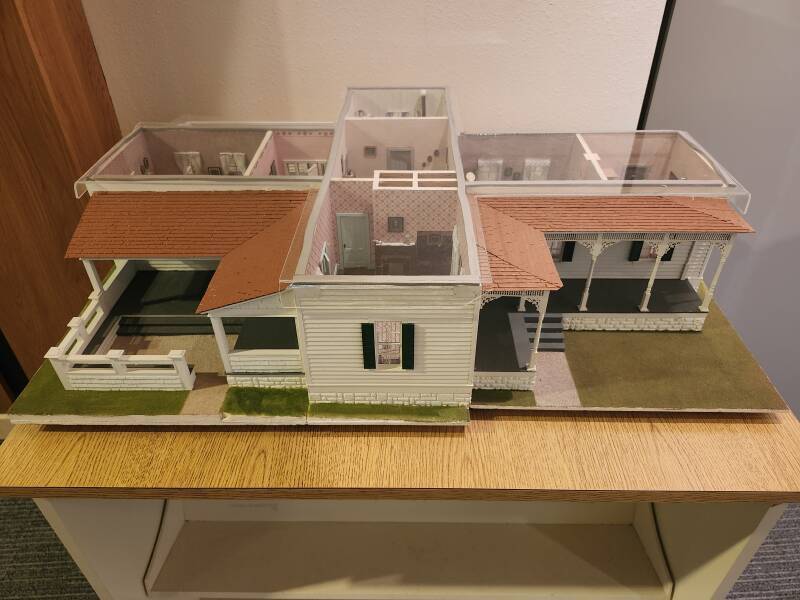
The model is displayed so you view the house from its front side, on the north.
In the center, from front to back (north to south, bottom to top in the picture), are the parlor, the dining room, and the kitchen.
To the left (or east) is the small passage or room leading to the original bedroom. That became the girls' bedroom when the Johnsons moved in. The screened-in porch is behind that, at the south-east corner (upper left below).
To the right (or west) of the parlor is the added wing, with the master bedroom in which the parents slept and the boys' bedroom beyond that.
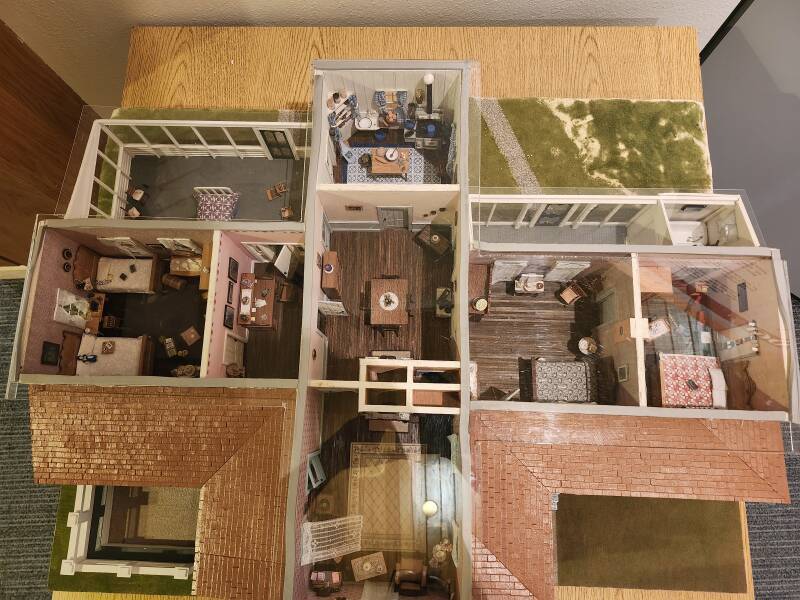
The southwest corner, upper right in this view, has a narrow screened-in porch with the bathroom at its far end. By the mid to late 20th century, the American English term "bathroom" meant a room that happened to contain bathing hardware such as a tub or a shower, but also had one or more plumbed-in sinks and a toilet, and possibly (at least mid-century) a bidet.
However, for the Johnson family in Johnson City, Texas, in the early 20th century, the bathroom was simply that — a small room containing just a tub plus a small cabinet on which a large ceramic bowl and pitcher were kept. The bathroom was for a bath, no more.
Below is a view of the back side of the Johnson home, looking at it from the southwest. The kitchen is the solid section extending out from the center. The bathroom is at the nearest corner, the outer third or so of what otherwise is a narrow screened-in porch. The sleeping porch is at the farthest visible corner, beyond the kitchen.
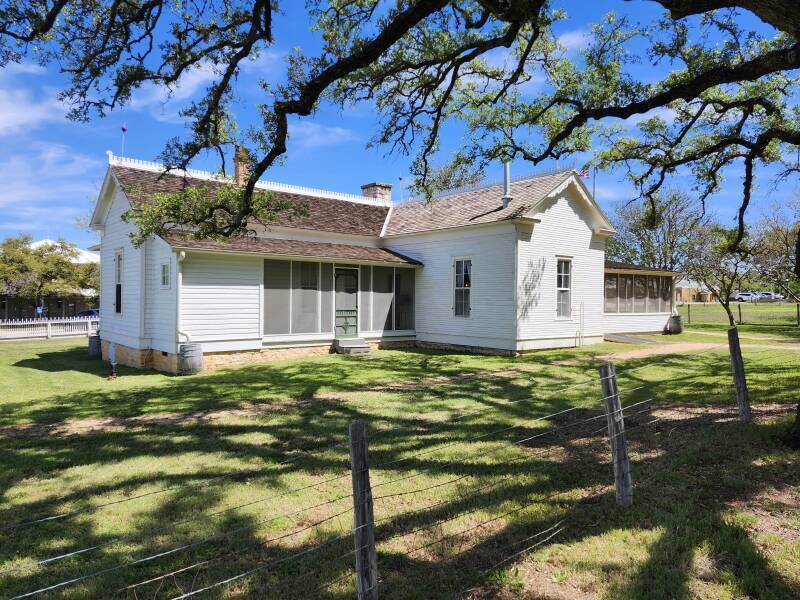
But Where Was The Toilet?
There wasn't one.
At least in rural Texas, this was the time of chamber pots in the house and an outhouse out back. Below is the view into the parents' bedroom from the porch on the right front of the house. The door to the right leads on into the boys' bedroom.
Notice the pitcher and large bowl on the cabinet between the two windows. Also notice the chamber pot to their left.
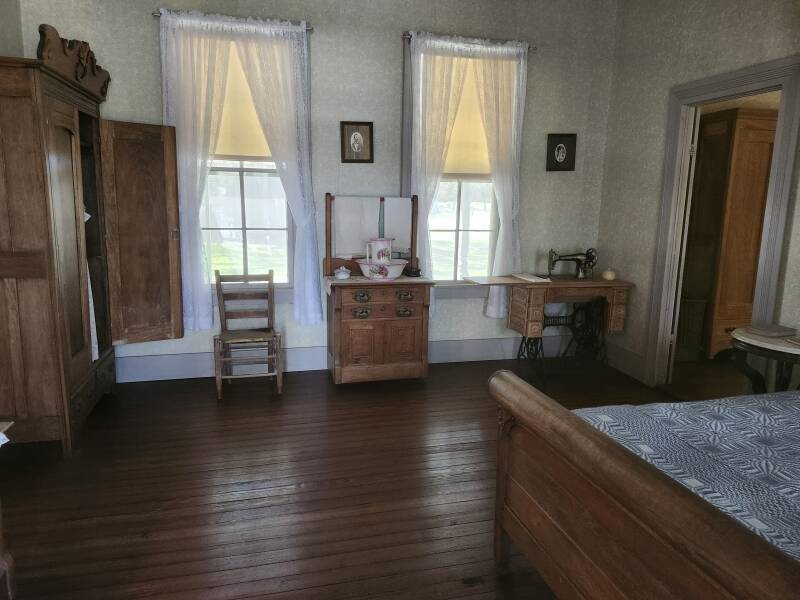
Of course there was no toilet paper. The pitcher of water and the large bowl were for washing up after emptying one's bladder and bowels into the chamber pot.
In the below picture, we're standing in the door from the dining room into the parents' bedroom. The boys' bedroom is through the doorway across the room.
Notice the second chamber pot on the floor under the parents' bed.
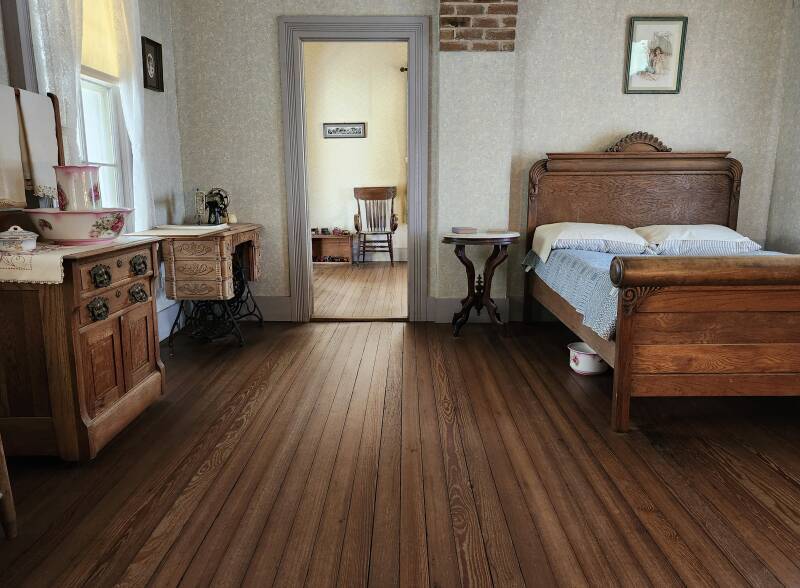
Is this a case of his-and-hers thunder mugs? Or should the National Park Service relocate one of them to the girls' bedroom, seen below with no visible chamber pot?
The Johnson City Foundation purchased the property in 1965, after Lyndon's election as U.S. President. Five years later, in 1970, the foundation transferred the property to the National Park Service. Some of Lyndon's siblings were also still alive, and they helped the NPS restore the home to its 1920s appearance. They donated some items that they still owned, and helped the NPS find replacements for others. They made sure that the furniture and fixtures were in the same places.
So, along with everything else, the chamber pots were located according to Lyndon's sisters' memory. Perhaps, to provide a balance to Lyndon's notorious sharing of his bowel habits, they demurely claimed that there wasn't a chamber pot in their room.
Below is the view into the girls' bedroom from the porch on the left front. We can see a large bowl and pitcher on a cabinet. No chamber pot is visible here. Maybe there's one underneath the bed seen at lower left. The pitcher and bowl were for use immediately after using a chamber pot, so I would say that it's either missing or simply not visible to visitors today.
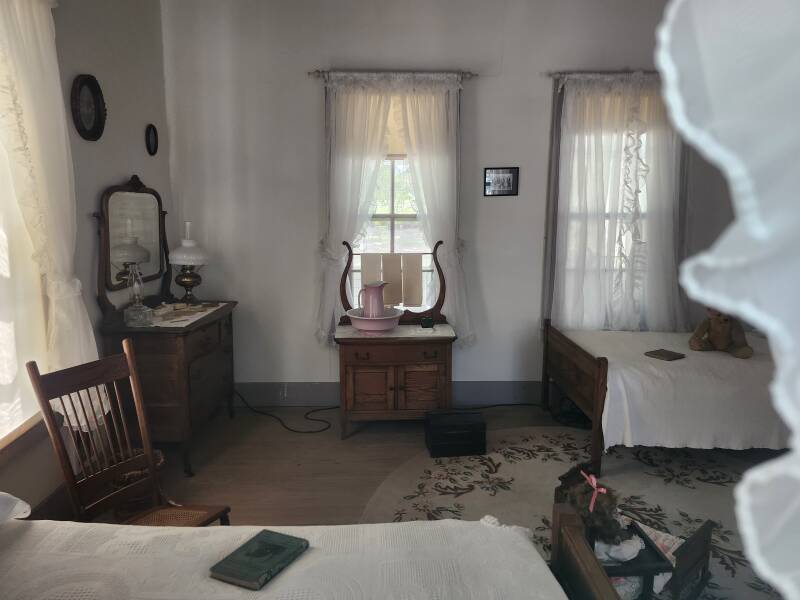
One doesn't become visible when looking into the girls' bedroom from the passage joining it to the dining room.
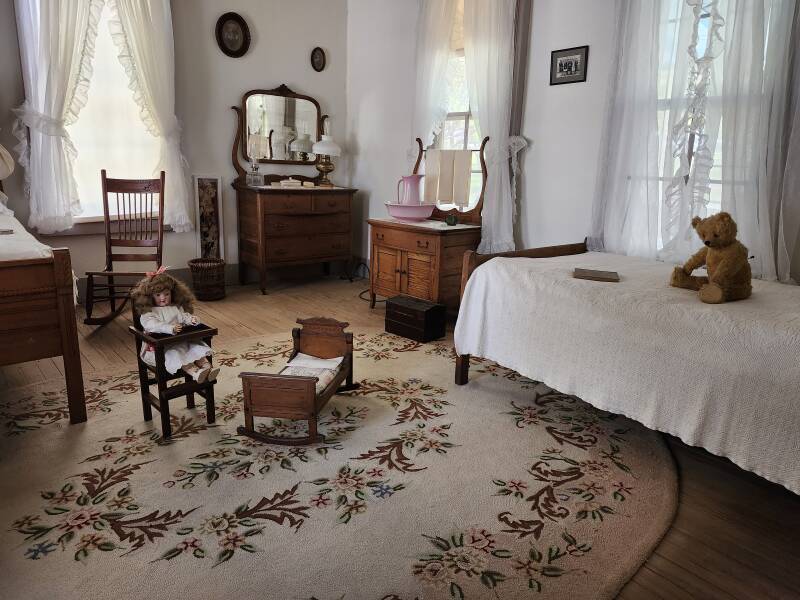
The single bed on the screened-in sleeping porch is accompanied by a chamber pot, and a washing bowl and pitcher.
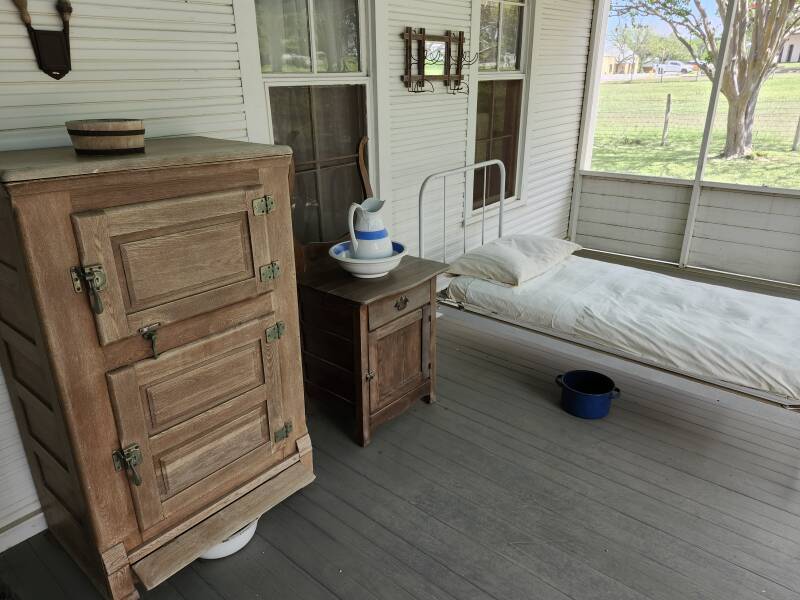
The large cabinet to the left is an ice box. Blocks of ice would be transported here from San Antonio and Austin.
Chamber Pots at Night, Outhouse During the Day
You would use the chamber pot during the night, to the delight (or not) of those sharing the room. In the morning, you would empty the chamber pot into the outhouse standing at the far back corner of the property. Today it's a grassy lawn, but back then it contained a large garden, some fruit trees, and pens for chickens and other small livestock.
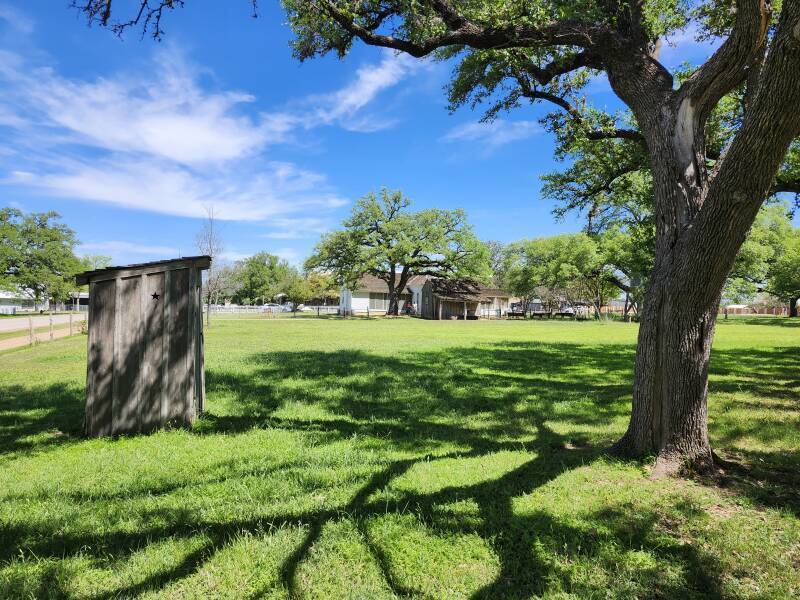
The outhouse is the first feature you encounter when you walk across from the visitors center to the house. A placard there shows the picture of Lyndon at 7 years old that appears so frequently due to the small number of photographs from that era. To its right, his cousin with a small horse, and below, Lyndon delivering a speech from the front porch during his 1941 Senate campaign.
There's no mention at all of the outhouse, but that's why you're here looking at the Toilet Guru's site!
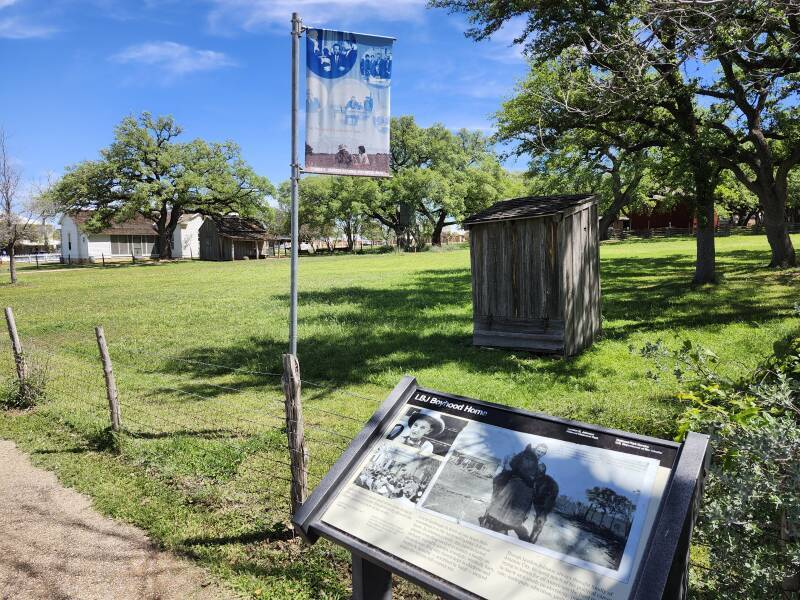
Notice the Texas-themed star providing minimal ventilation and light.
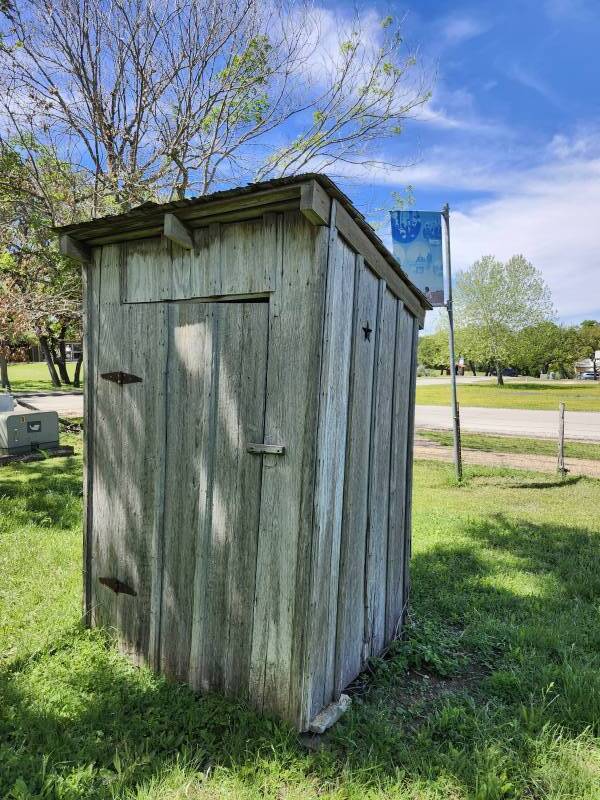
Is this exactly where the outhouse was when Lyndon grew up here? Not really, because an outhouse had no precise long-term location. You typically moved an outhouse from time to time.
"Gong farmers" in 17th & 18th century England Ernest Hemingway on cesspit excavation in 1920s ParisYou would dig a bottle-shaped cesspit and place an outhouse above it. Liquid waste would seep out into the surrounding soil, while solid waste accumulated. When the pit filled, you could move the outhouse to the side, dig out most of the solid waste, and move the outhouse back into place.
In a densely populated city like London or Paris, cesspit excavation or "gong farming" was a crucial public service. See this site's pages on the history of public toilets and the history of squat versus seat toilets for the concerns of filled-up urban latrines. But in a rural setting or a small town, you would dug a new pit and shift the outhouse.
Ground-penetrating radar could reveal previous outhouse locations, depending on whether the ground conditions could show a contrast between undisturbed soil and filled-in pits.
The next stage of toiletological science would then lead to excavating the earlier pits while searching for indications of parasite infections in the residents. Other pages on this site describe that science in action in the settlements on the sacred Aegean island of Delos from 900 BCE to 100 CE, along the Han Dynasty Silk Road of the first century CE, in Hanseatic League cities of Europe from the late 1100s to the mid 1400s, in an Augustinian friary in Cambridge, England in the 1100s through the 1300s, and in the Crusader castles of the 1400s, among other locations and times.
Let's peep in through one of the Texas star-shaped vents:
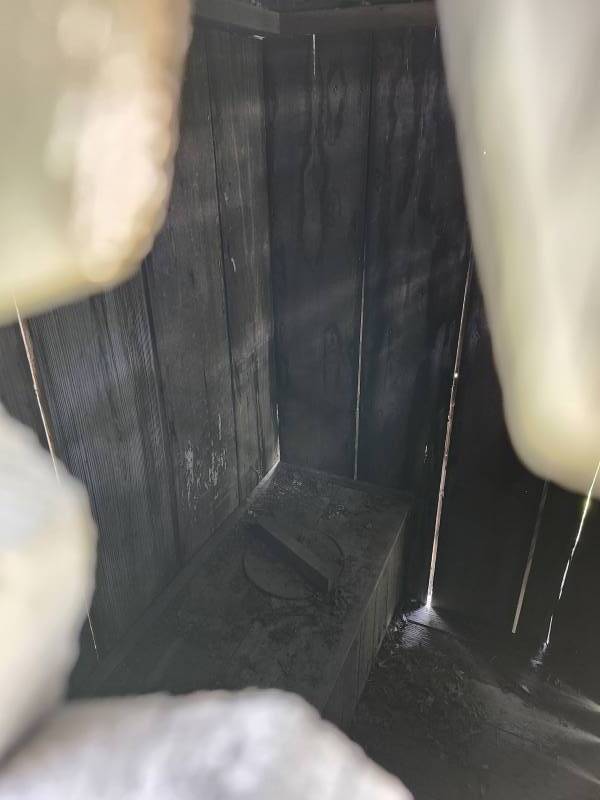
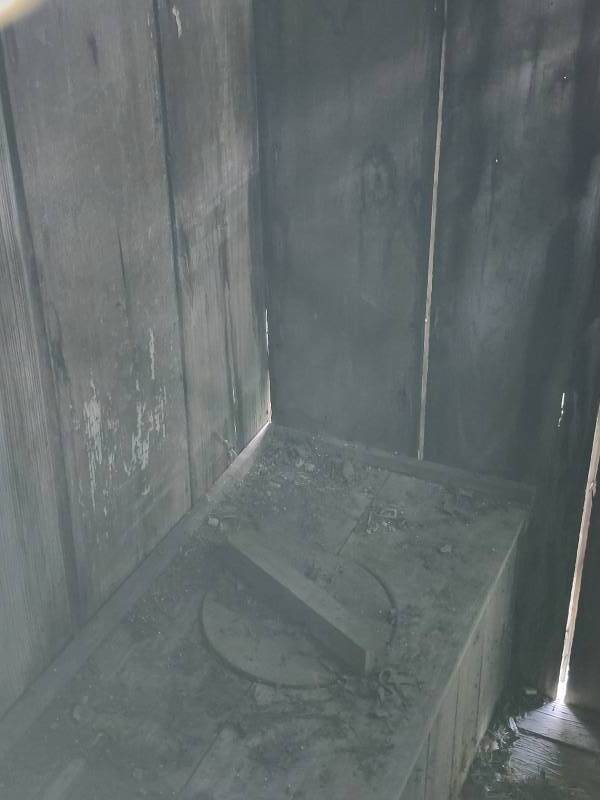
The Literal Bath-Only Room
Here's that small room at the southwest end of the back porch, with just a bathtub plus a cabinet.
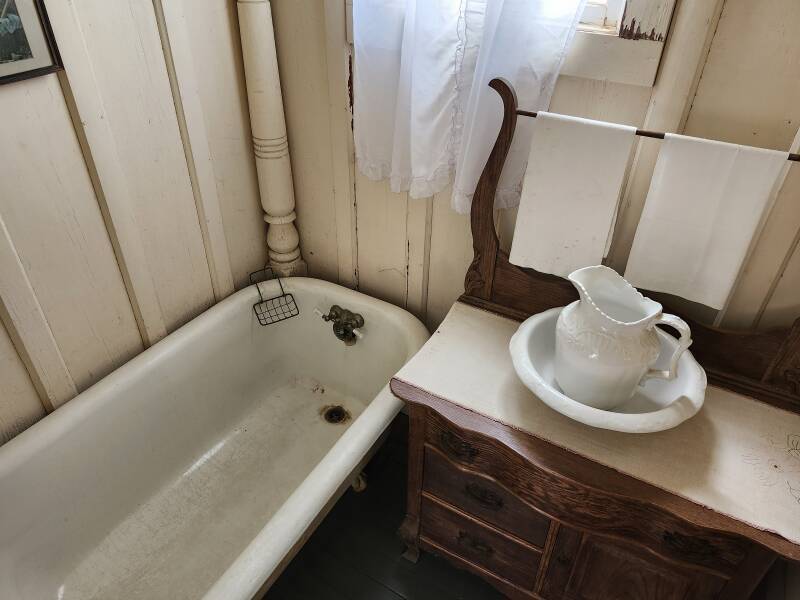
A door opens into this bathroom from the boys' bedroom along its long side, off to the right in the above picture.
A second door also opens into it from the narrow porch running along the southwest side of the house, off to the left in the above picture..
As for the light blue ceiling above the white walls in the pictures of the porches,, 1920s Texas shared a belief with the Greek islands that the color combination repels insects and other pests. The sleeping porch had a similarly colored ceiling.
Both Greek and Russian have separate words for what English describes as shades of a single color blue, saying instead that what English calls "light blue" and "dark blue" are unique colors with their own names — galazios and goluboy versus ble and siniy. In Texas, however, they just say "blue".
|
γαλάζιος
голубой #00BFFF |
μπλε
синий #004DFF |
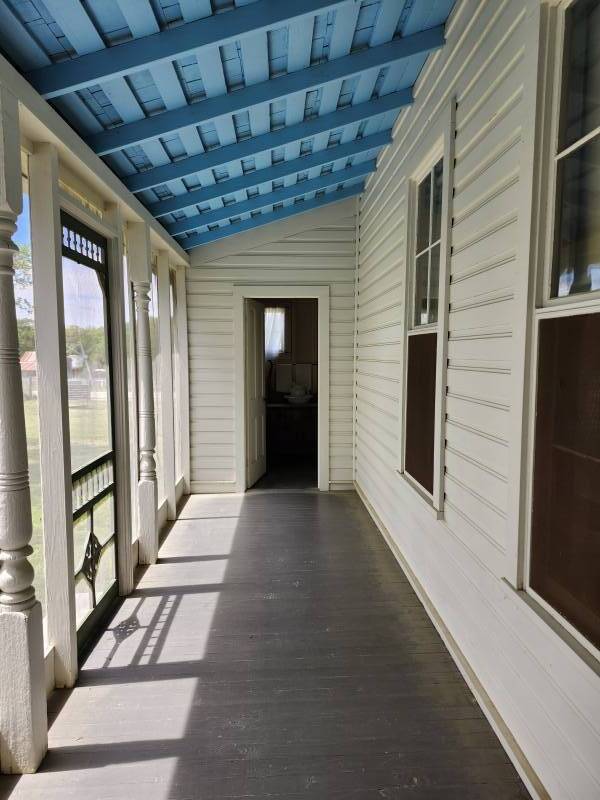
Plumbing and Other Logistics
That bathtub you saw above had a drain leading off to somewhere — out underground behind the house under what was the garden, orchard, and livestock pens. But what other plumbing did they have?
Here's the kitchen. Notice the sink with a similar drain. To the right is a stove where water could be heated for a warm bath.
The sink also has a faucet, what's up with that? There was no municipal water system. That faucet was supplied by the family's private water tank, which we see below.
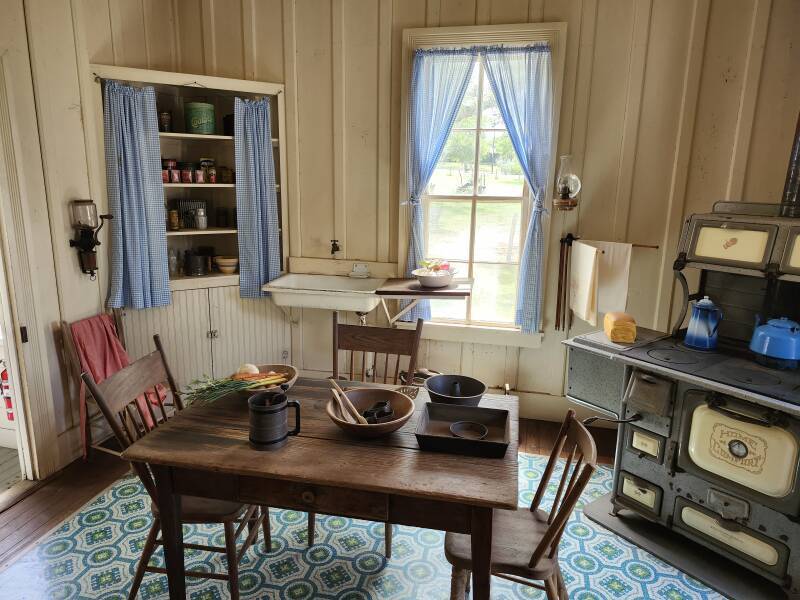
But first... The above picture looks from the dining room door into the kitchen. Let's look around the dining room while we're there.
Out the back of the house and to the right led to the outhouse. But out the back and to the left led to the barn, where they kept their Model T car.
As the older boy, Lyndon would be sent out pretty much every evening to disconnect the battery from the family's car, carry it into the dining room, and connect to their radio.
MW DXTheir Atwater Kent Model 20 radio was their connection to the outside world. The family would listen to AM or medium-wave broadcast stations in Austin and San Antonio, their immediate link to the outside world. The Model 20 had five 201-A vacuum tubes — two in the RF stages, one as the detector, and two audio amplifier stages. The 201-A is a four-pin triode that requires 250 milliamps of 5 V filament power. The Johnsons would have to start the Model T from time to time to keep the nightly listening sessions from running the battery down.
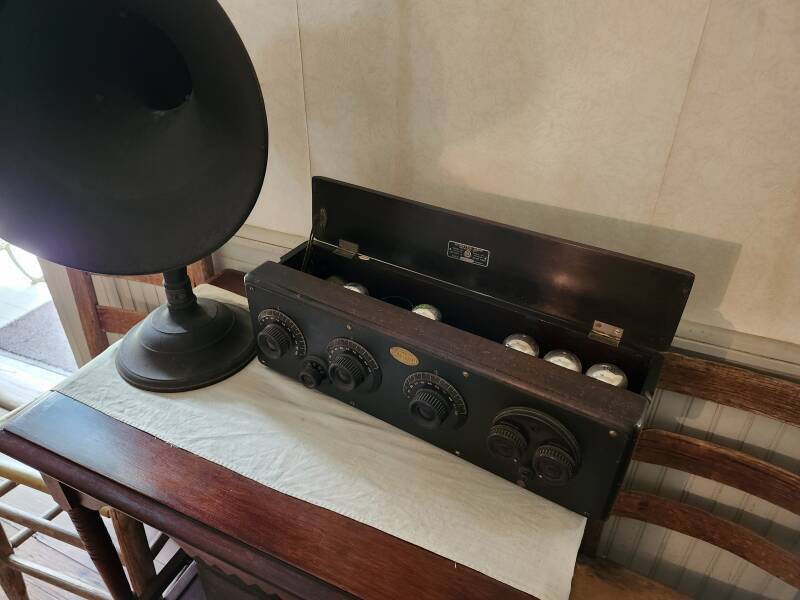
The power supply of a radio of that era included a vibrator, analogous to what we now call a switching power supply. That device uses a relatively low voltage battery to generate a 90–150V DC plate voltage supply. The filaments ran directly off the battery.
Lyndon greatly appreciated how the radio connected the family to the world at large. But he also was all too well aware of the difficulty involved in carrying the heavy lead-acid car battery back and forth. When he entered national politics, one of his goals was furthering the rural electrification program started by Franklin Roosevelt in 1935.
By late 1939, the Pedernales Electric Cooperative had installed lines bringing electrical power from two dams on the Colorado River to Johnson City and surrounding farms. The PEC office was established just across the street to the east of the Johnson property. It became the nation's largest electric cooperative.
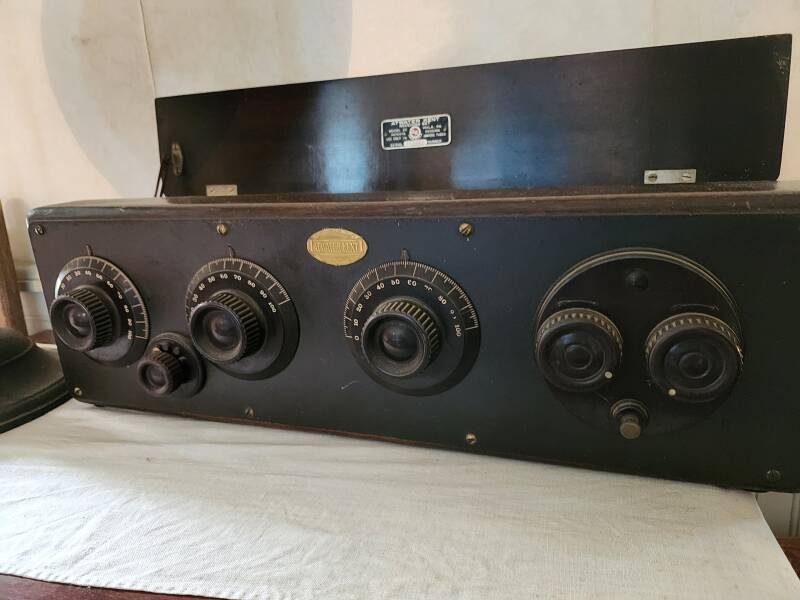
So, What About the Johnson Family's Private Water Supply?
Behind the house was a well with a windmill-driven pump and a water tank. These date from when Lyndon was growing up here, and the oak tree has grown up around them.
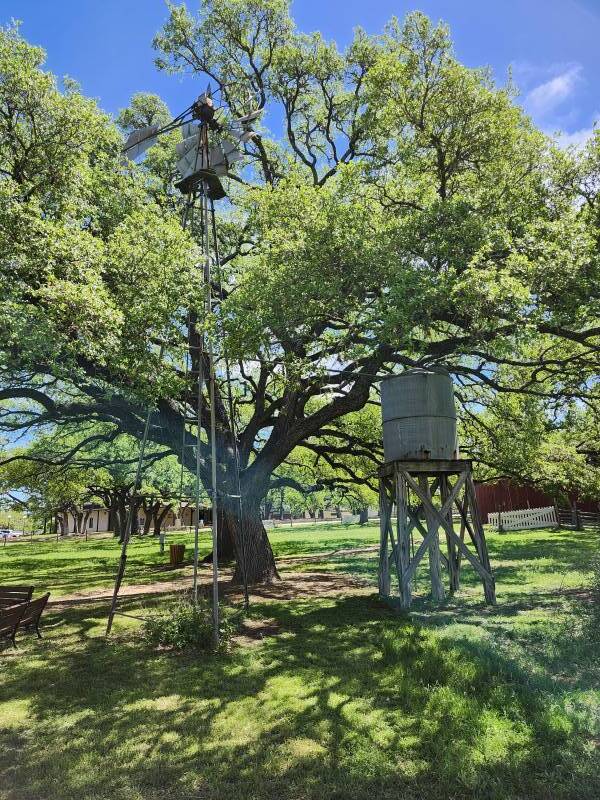
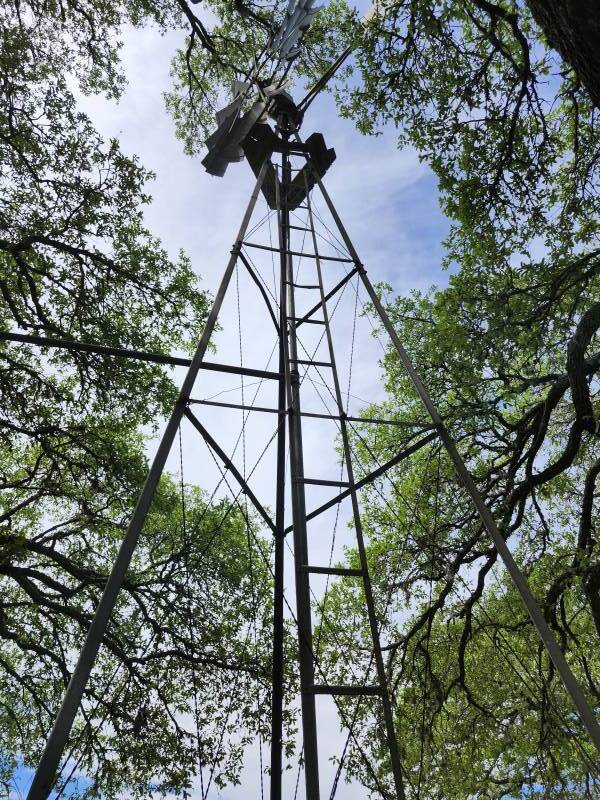
The hub at the center of the windmill vanes has a rotating connection a little way out from its center. A long rod connects to that.
Each complete turn of the vanes moves that rod up and down maybe six inches. The rod goes down the pipe into the well. About halfway up the windmill, a tee connector leads to a pipe running horizontally, level with the top of the water tank.
The rod continues down inside the pipe and into the well. Below the water level within the pipe, the rod pulls and pushes a flapper valve up and down. So, each rotation of the vanes pushes a little more water up the pipe.
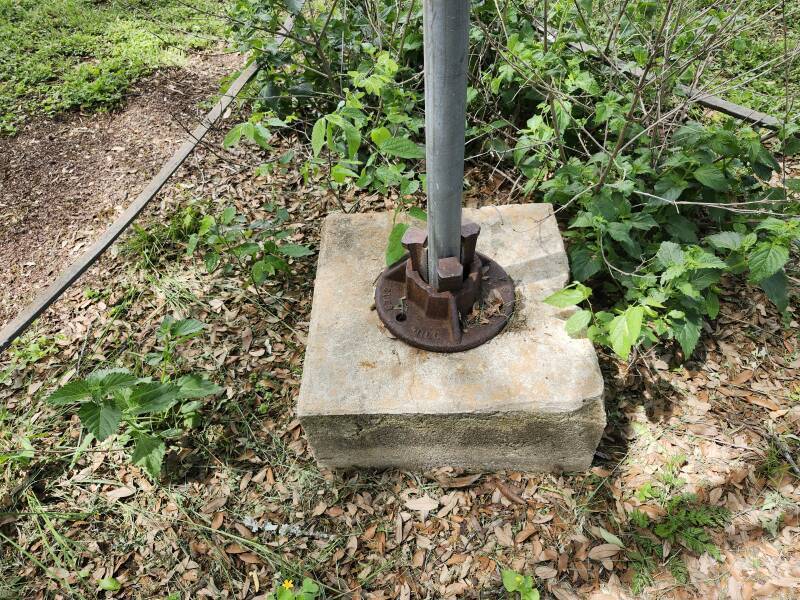
The water is pumped up to that tee connector halfway up the windmill vanes, where it flows through the tee and across to the tank. From the tank, a pipe runs down into the ground and then turns and runs into the house.
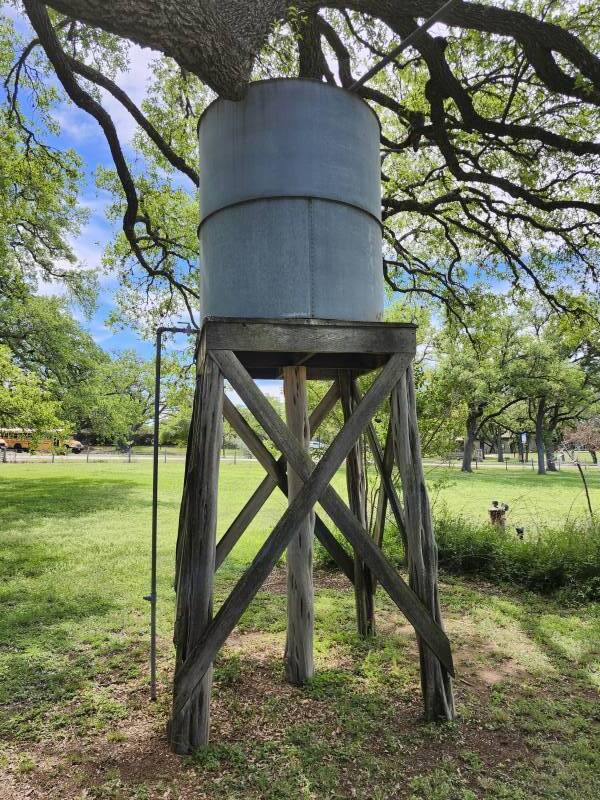
Rain barrels collect water off the roof at corners of the house. In the distance, by the fence along the street, we can see a covered cistern.
The rain can come in storms. Lightning rods along the central peak of the roof aim to bleed electrical charge off the house before it builds up to the point that lightning would strike.
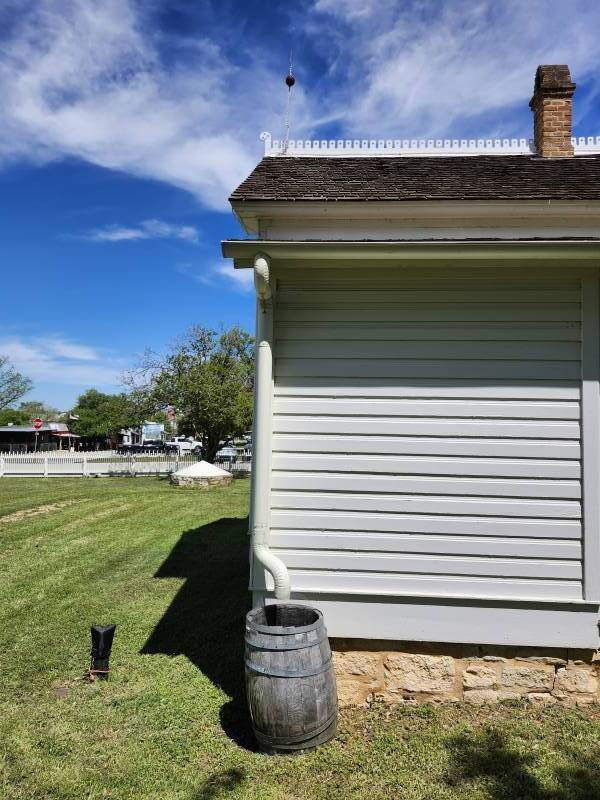
The Johnson Settlement and its Plumbing
In the late 1850s, Lyndon's grandfather, Sam Johnson, settled nearby with his brother Tom in a one-room cabin with 320 acres or 130 hectares of land. The Johnson Settlement is a short walk to the west from the boyhood home and the visitors center.
Sam married after the Civil War ended in 1865, and the brothers expanded the one-room cabin into two rooms with a covered passage in between.
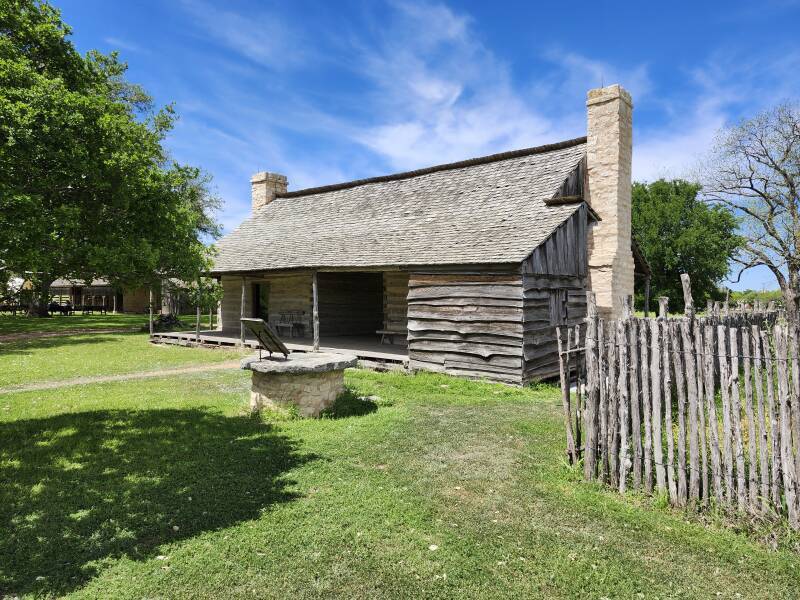
The local terminology insists on calling this design a "dogtrot cabin" because a dog could trot through the passage between the two sections. (What appears to be a second through passage toward the left in the below picture is the result of the front and back doors on that half being open)
OK, fine, but any North American land mammal other than a moose or elk could move through the center passage at a trot, run, or sidle.
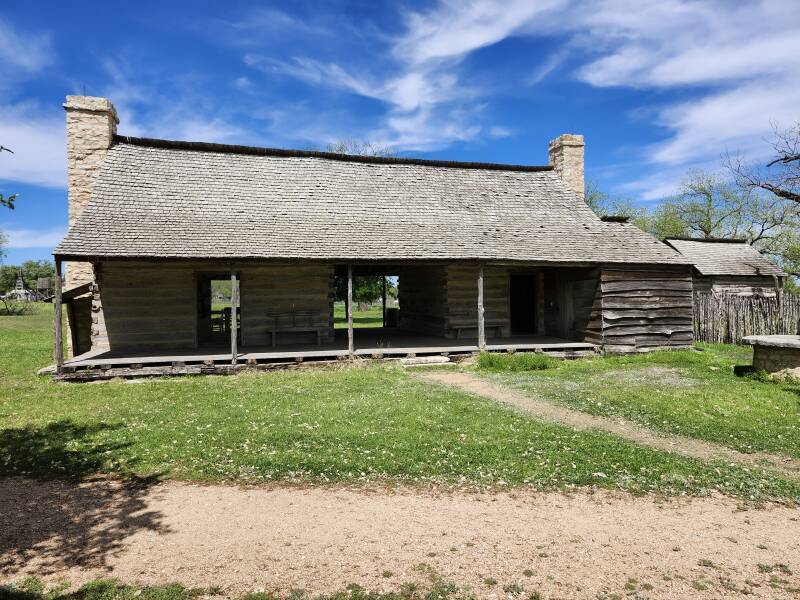
The Johnson brothers were cattle speculators. Their settlement became headquarters for the largest cattle driving operation in seven counties. They soon purchased an additional 640 acres of land.
They would buy cattle on credit in the spring, promising to eventually pay six to ten dollars for each animal. They and their men would drive the cattle north along the Chisholm Trail, selling them for thirty to forty dollars each at markets near major railroad stations in Kansas. They would return to Texas in the fall and pay for the credit purchases made in the spring.
For two or three years, Sam and Tom became fabulously wealthy. But then many other men entered the cattle business, the supply of animals flooded the market, and the prices paid for delivered cattle crashed. Sam moved to some land thirteen miles to the west.
Sam, Jr., Lyndon's father, also became involved in speculation, and also fell victim to a boom-and-bust cycle. He did well in the cotton futures market in 1902, 1903, and 1904, and then lost all his money in 1905. He later bought and sold real estate and various businesses, and later tried to get back into cotton speculation, and he always quickly lost almost all his money.
Here's a view through the cabin on the left side of the above view. There's the chamber pot.
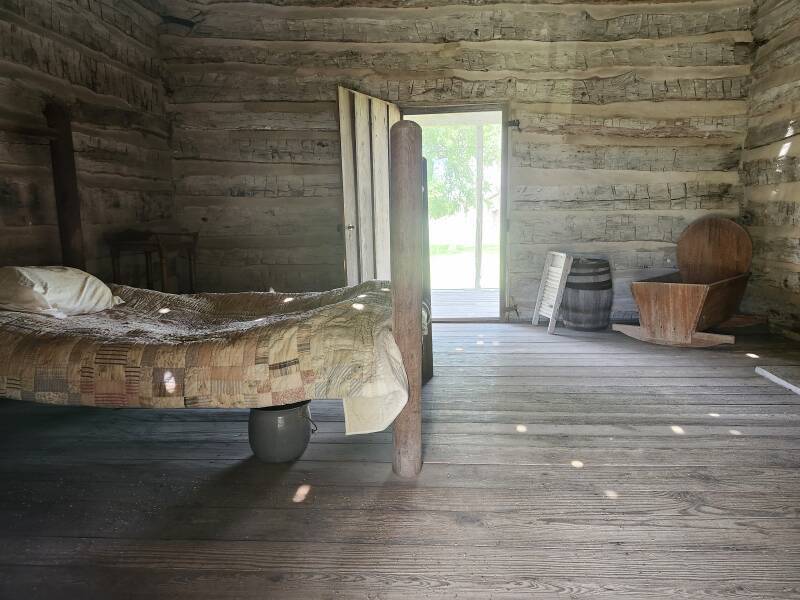
From the back porch, we see the outhouse.
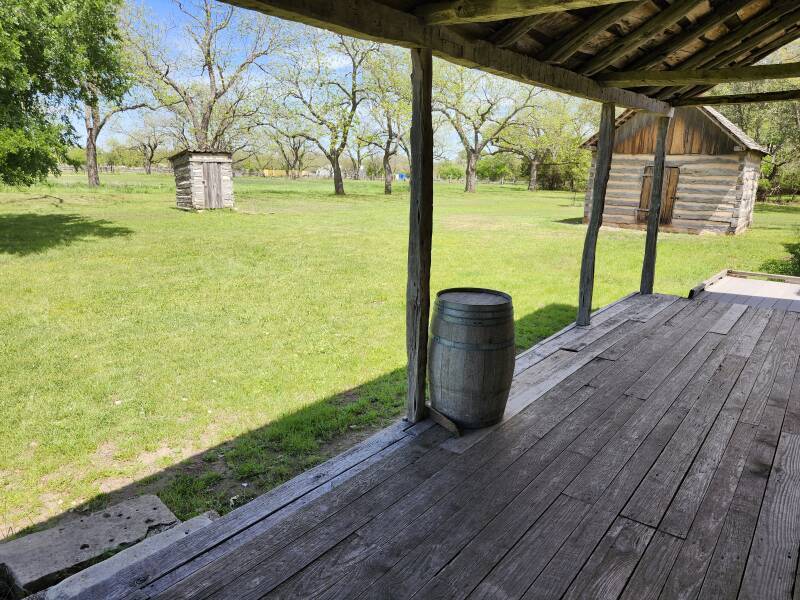
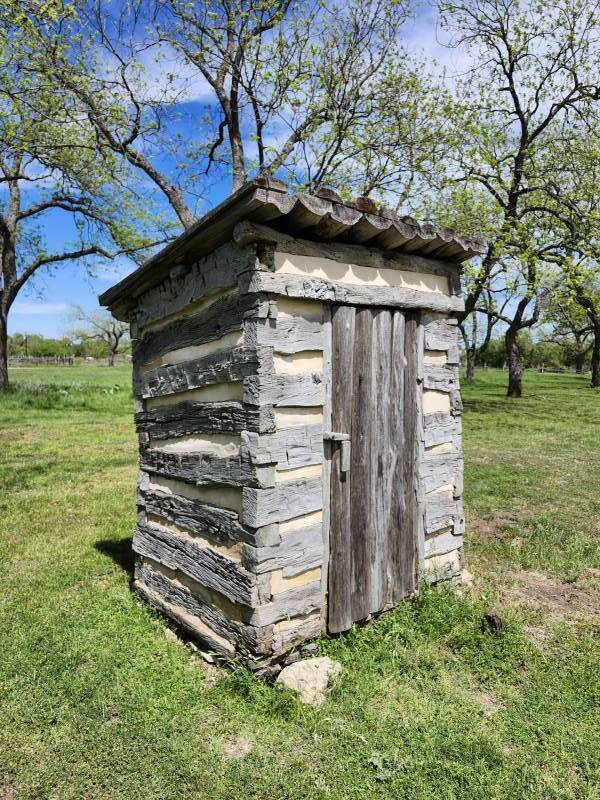
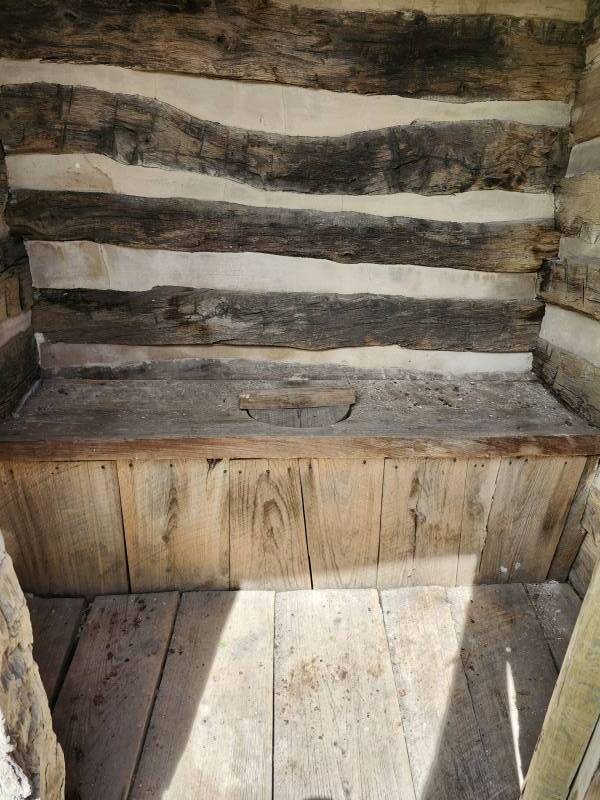
A similar windmill and elevated tank stand beside a nearby storage building.
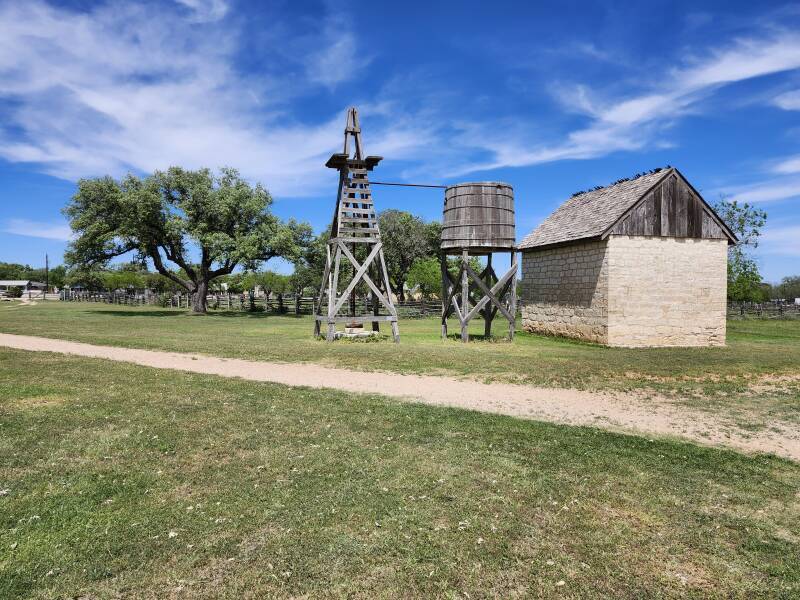
I was visiting in April 2024, to see the total solar eclipse in addition to local history. The Hill Country west of Austin is covered with wildflowers like these bluebonnets at that time of year. This shows just some of the flowers at the Johnson Settlement.
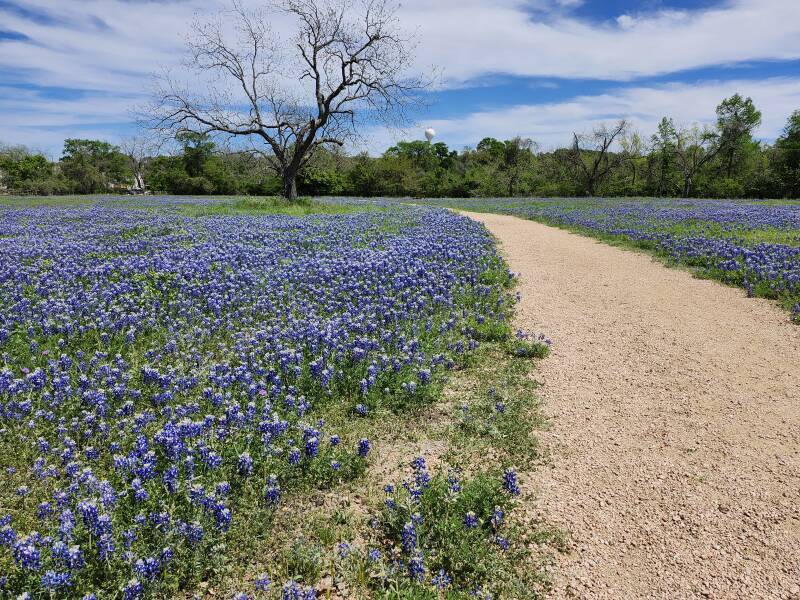
Reconstructed Birthplace and the LBJ Ranch
The family was living thirteen miles to the west of Johnson City when Lyndon was born in 1908, three years after the first of his father's serial bankruptcies. They lived in a house that Sam, Sr., Lyndon's grandfather, had built in 1889. Below is an early photograph with Sam and his wife Eliza at the center, and other family members. Lyndon's father, Sam Jr., is probably at the far left or far right.
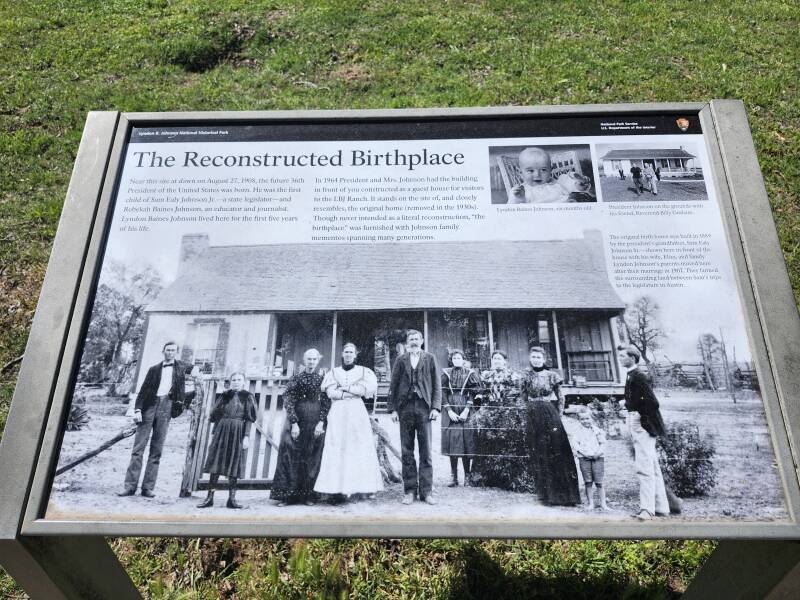
Sam Jr, Lyndon's father, sold the property in 1922 and the house was torn down in the 1930s.
Lyndon and his wife, known as "Lady Bird", purchased a nearby larger house and some property from one of Lyndon's aunts in 1951. That property, which they continued to add to by buying parcels, became known as the LBJ Ranch. It's a mile to the west of the cabin where LBJ was born.
Lyndon was elected Vice President in 1960, and became President in November, 1963. He spent over 20% of his time as President at the LBJ Ranch, which became known as "the Texas White House". He had advisors, staff, U.S. political figures, and foreign visitors stay with him at the ranch complex.
In 1964 Johnson commissioned an Austin architect to design and build an approximate reconstruction of his birthplace. That reconstruction is what you see today. As the National Park Service described it:
He based it on a thorough archeological investigation, information supplied by family members and others who remembered the house, and contemporary photographs. Some of the materials utilized in the reconstruction came from an existing building nearby and may once have formed a part of the birthplace.
The reconstruction is a typical Texas farmhouse of the late 19th century. An open central hallway, or "dogtrot," runs between two large rooms on the east and west sides. In the outer wall of each room is a stone fireplace with wooden mantel. A wooden porch, the western end of which is enclosed to provide a "shed room," extends across the entire front of the structure. An ell to the rear of the western room contains a dining room, old kitchen, and a modern kitchen that did not exist in the original house. To the east of the dining room is a back porch, a shed room, and a modern bath. The house is furnished with Johnson family items or period pieces.
The modern bath was being renovated when I visited, so the public was provided with portable toilets.
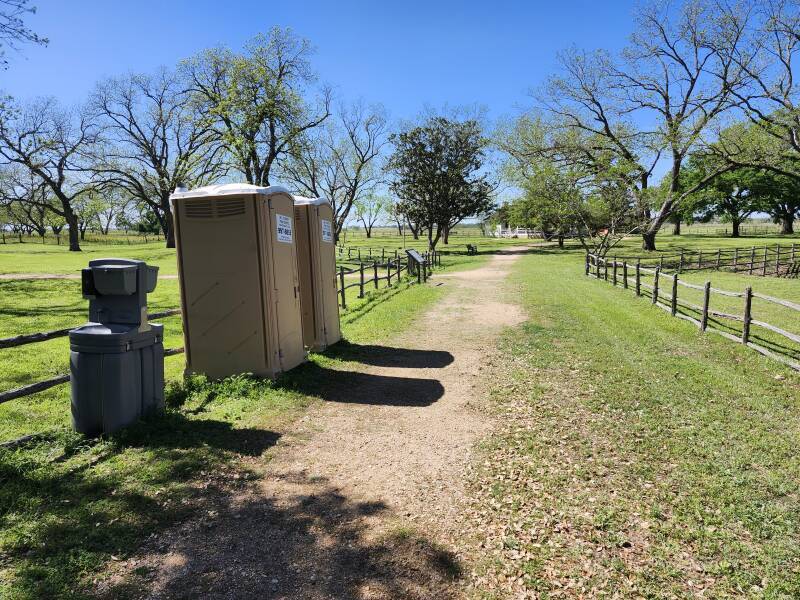
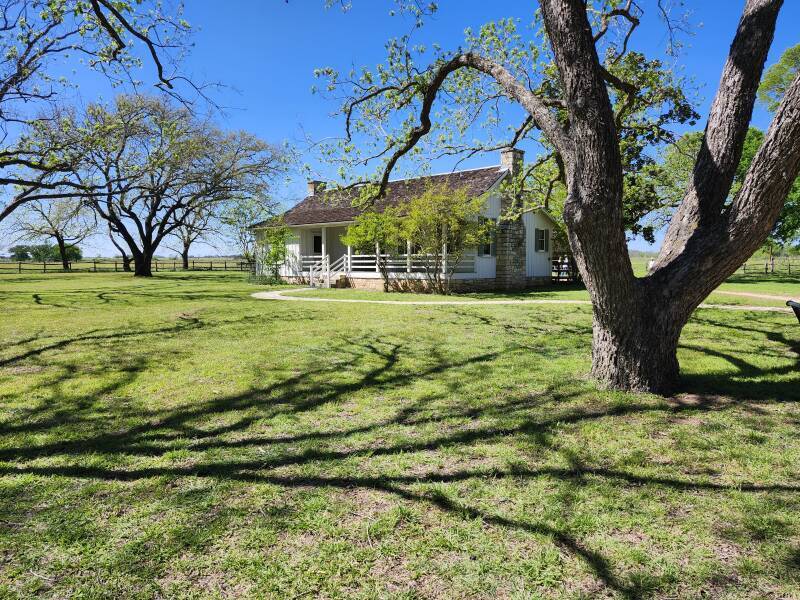
The birthplace became a combined guesthouse and Johnson's museum of his origins.
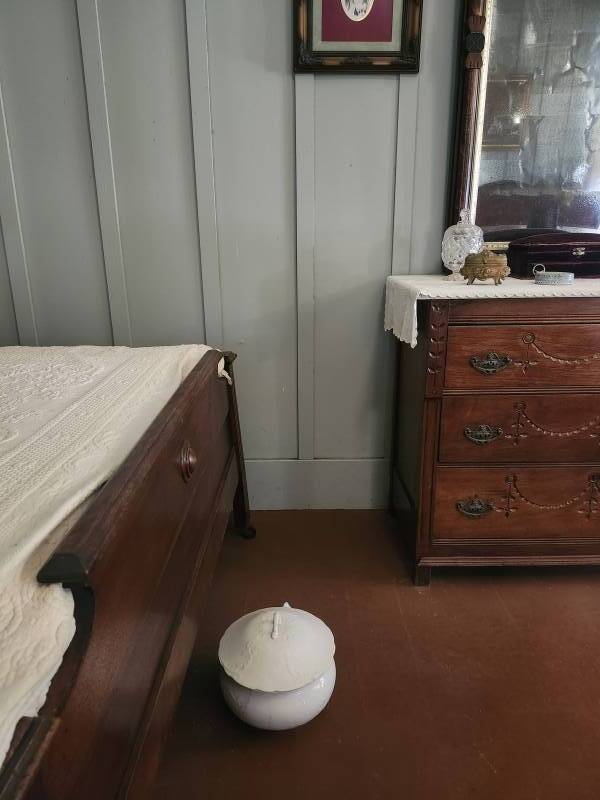
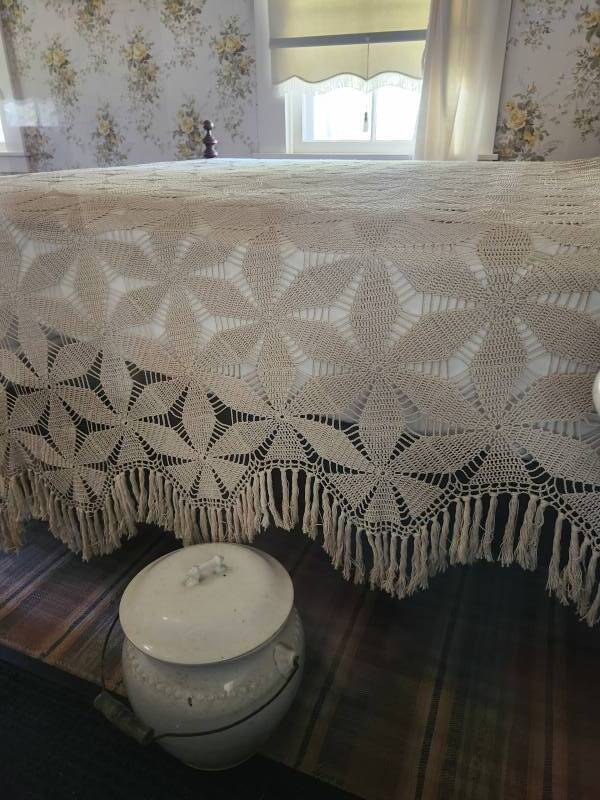
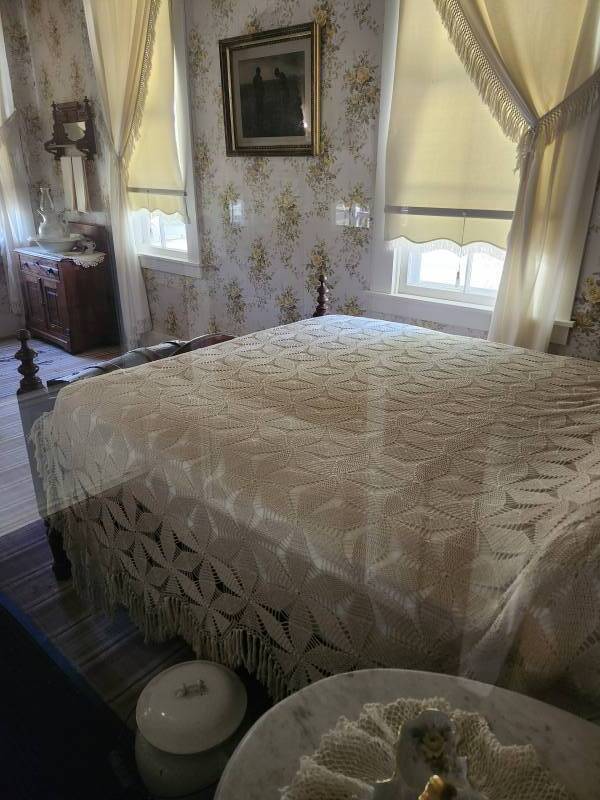
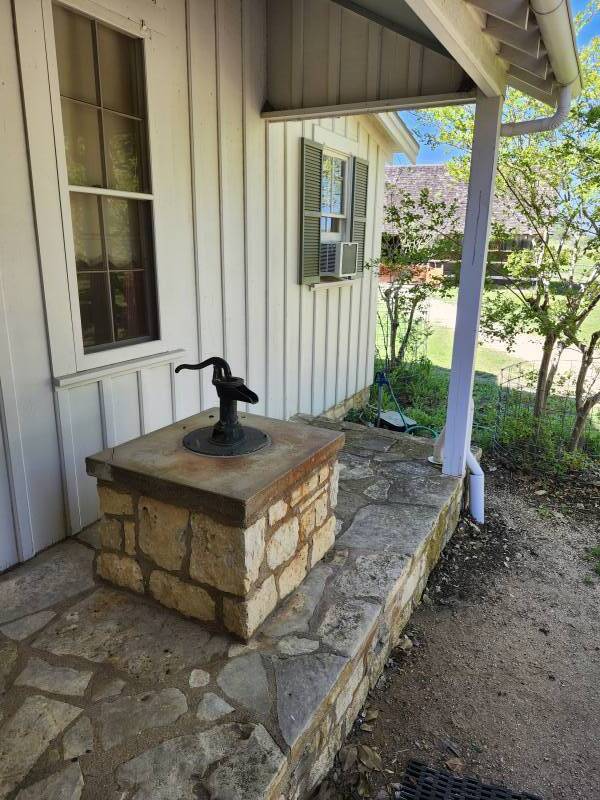
Johnson was photographed demonstrating the water pump to Willard Wirtz, Secretary of Labor, and Luther Hodges, Secretary of Commerce. The same placard says that other guest houses were built, including the Cedar Guest House where the actor Gregory Peck stayed while visiting.
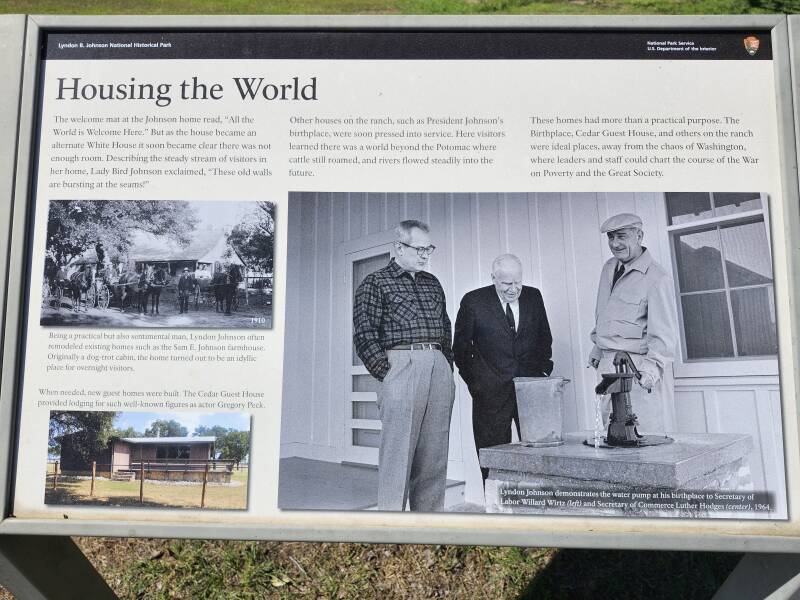
The vintage chamberpots and reconstructed outhouses would have been a part of this. Johnson thought that John Kennedy, his brother Robert, and their staff and advisors were a group of effete northeasterners. Not all of Kennedy's Presidential staff stayed on with Johnson, but for those who did, he took delight in any discomfort they felt in the rural Texas setting.
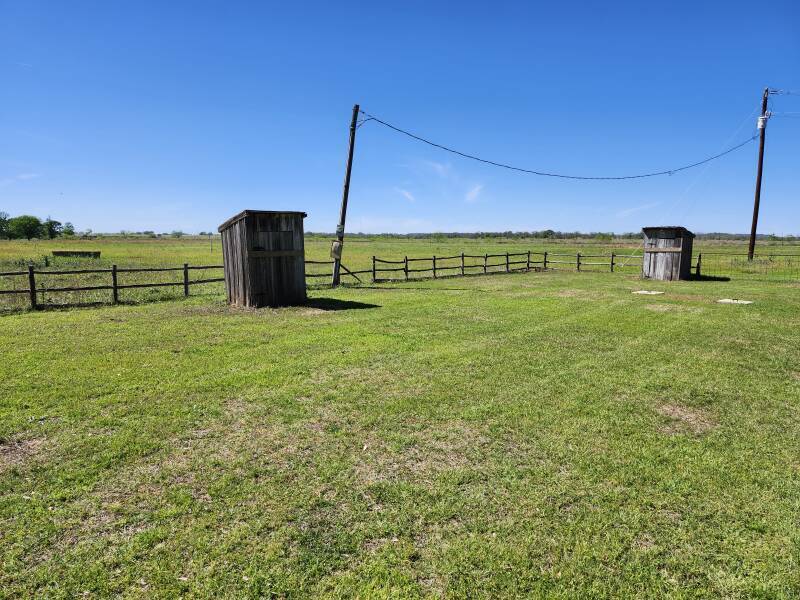
Would Lyndon Johnson send McGeorge Bundy, Robert McNamara, Pierre Salinger, and Dean Rusk off in pairs to use the two-holer outhouses? Possibly.
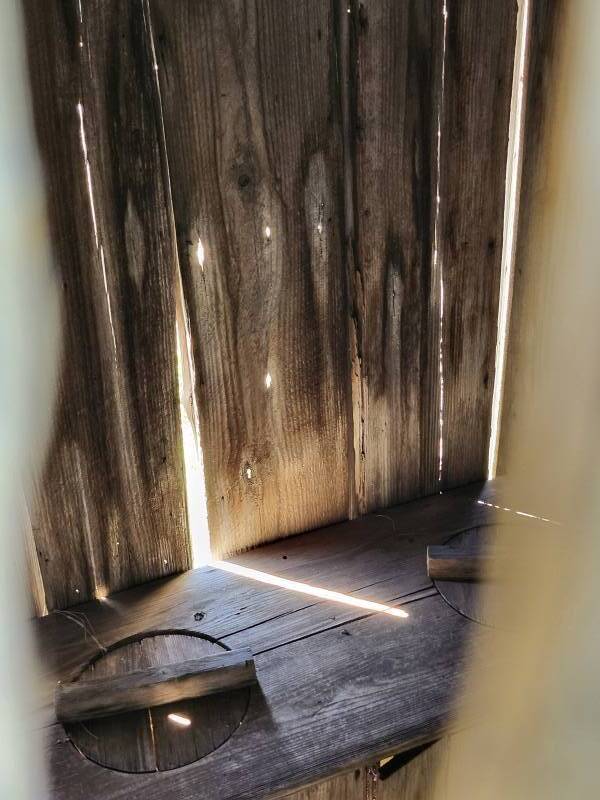
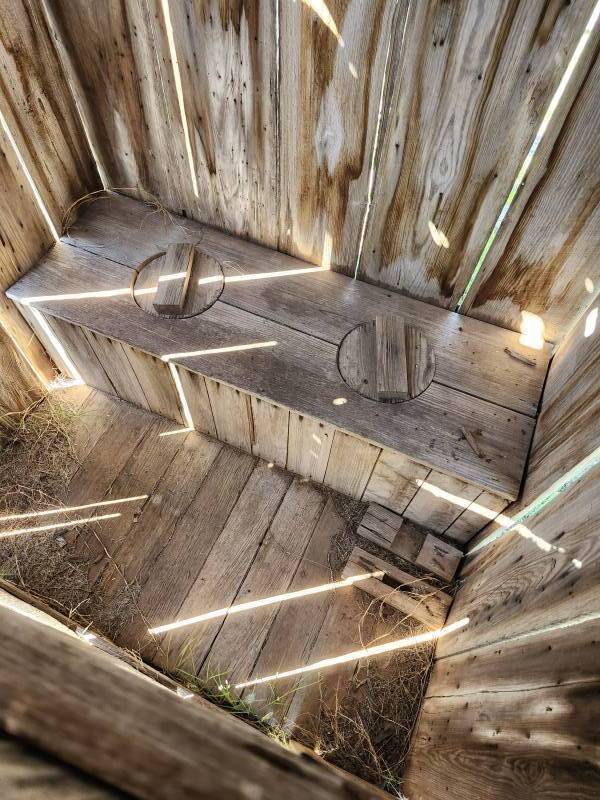
The ranch had a 3,000-foot grass airstrip in 1953. Within eight years it was paved and extended to 6,300 feet. The Boeing 707 was the standard U.S. Presidential transport aircraft by then, but the ranch runway wasn't large enough for it. Johnson would fly the standard 707-based transport to Bergstrom AFB, southeast of Austin, and then a Lockheed JetStar designated as a VC-140B to the ranch. Bergstrom AFB was closed in 1993, and converted into the Austin-Bergstrom International Airport.
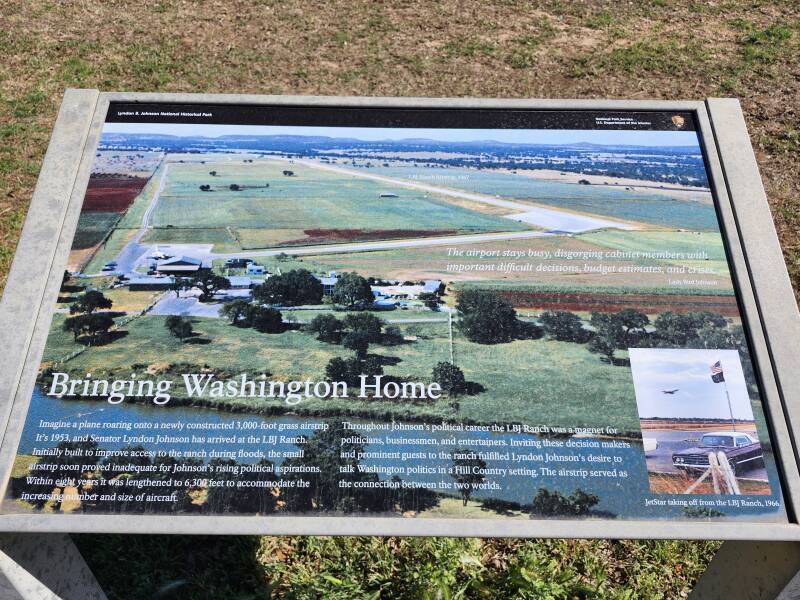
The "Texas White House" portion of the LBJ Ranch complex closed for major repairs in 2018. When I visited in 2024 they were saying that it was scheduled to re-open in 2025. And so, I didn't get to see the ranch house and its bathroom.
FalloutShelter
Plumbing
Maybe it was all those evenings of the Johnson family gathered around the Atwater Kent radio that led Lyndon Johnson to be an aficionado of telecommunications. He expanded the telephone system in the White House, and had a curving cabinet with three television sets along the wall of the Oval Office. Volume controls were on his desk.
The Cuban Missile Crisis of October, 1962, had highlighted the short time scales and need for constant connectivity for U.S. senior leadership. A terminal for a multi-line telephone system was installed next to his toilet. With the house closed, I had to make do with a postcard:
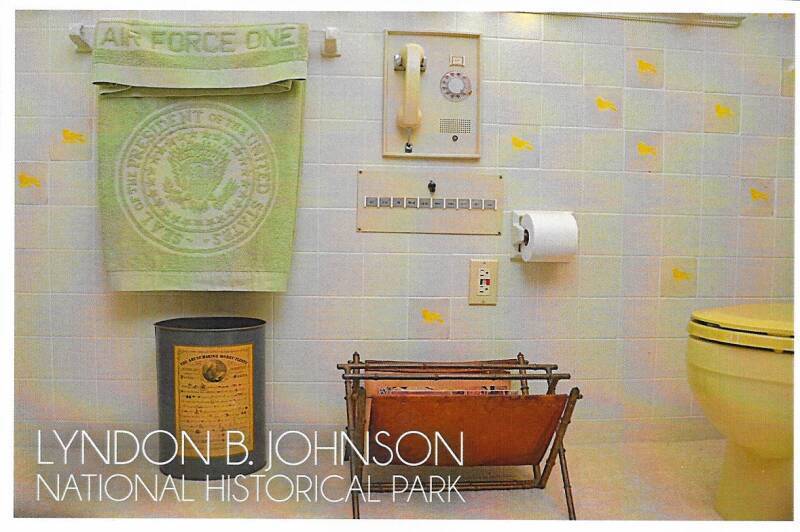
As for the comment at the top of this page about Johnson's somewhat peculiar attitudes about using the toilet, the preface of J.J. Parker's biography Lyndon Johnson depicts the 36th U.S. President as:
... perhaps America's earthiest President. He many times adjourned a White House meeting, saying he and the other men present needed exercise. They then would, at his direction, repair to the White House pool. Often the others would complain that they had no swim trunks, and therefore could not swim; LBJ cheerfully would reply that they didn't need trunks. All the men would swim naked, in a sort of bonding ritual orchestrated at Johnson's direction. Any self-conscious man passing on the "exercise" would, in Johnson's mind, be considered to lack guts — perhaps a "Kennedy man," prim and proper, but not a "real man." Also, Johnson seemed to enjoy shocking such people; he'd hold conversations while defecating on a White House toilet as another, embarrassed, man faced him (stall door open), and on one memorable occasion, he called aides into a White House room to speak with them while he lay on his side, his bare buttocks receiving an enema inserted by a nurse.
The legends say that John Kennedy and Marilyn Monroe would swim naked together in the pool in the White House basement. But then Johnson would say that all-male nude swimming parties were somehow more masculine.
Johnson's successor, Richard Nixon, had the White House swimming pool filled in and a bowling alley built in the space. He never insisted that Henry Kissinger or Spiro Agnew join him for pantsless bowling, as far as I know.
Aides who were reluctant to follow Johnson to the toilet were sources of great amusement to him. As reported in the book Real Life at the White House: 200 Years of Daily Life at America's Most Famous Residence:
The president, in turn, was always accessible — also when he was in the bathroom. LBJ exposed his body without inhibition, and at times quite deliberately. On one occasion he brought National Security Adviser McGeorge Bundy — whom he called "one of those delicate Kennedyites" — right into the bathroom with him. "[He] found it utterly impossible to look at me while I sat on the toilet," Johnson related. "You'd think he'd never seen those parts of the body before. For there he was, standing as far away from me as he possibly could, keeping his back toward me the whole time, trying to carry on a conversation. I could barely hear a word he said. I kept straining my ears and finally I asked him to come a little closer to me. Then began the most ludicrous scene I have ever witnessed. Instead of turning around and walking over to me, he kept his face away from me and walked backwards, one rickety step at a time. For a moment I thought he was going to fall into my lap. It certainly made me wonder how that man had made it so far in the world."
Robert Dallek's Lone Star Rising: Lyndon Johnson and His Times, 1908–1960 (pp 101–102) describes Johnson's treatment of one of his aides:
Toward Jones, who was better educated, much less dependent, and a prim, aloof personality, Lyndon was even more abusive. He would publicly ridicule any error he found in one of his letters, belittling his style of writing, his spelling, his typing, or any failing that put him in a subordinate position. But the worst moment in a day for Jones was when Lyndon would insist that he come into the bathroom while Lyndon sat on the toilet defecating. Jones "would stand with his head and nose averted, and take dictation." To some other, later employees, this was an example of Lyndon's "naturalness," but for Jones it was a source of humiliation and a means by which Lyndon dominated him or exercised control.
The most surprising part of all this is that Johnson,
very likely without realizing it,
was actually enacting traditions
going back to descriptions in the Hebrew Bible of
Late Bronze Age and Early Iron Age rulers.
Not caring about your privacy was a clear sign of
power and dominance.
King Eglon of Moab (soon after 1380 BCE)
and King Henri III of France (in 1589)
were both assassinated by someone consulting them while
they sat on the toilet.
Roman Emperors Nero and Galerius had
large multi-person toilets in their palaces.
For more details on this phenomenon, see:
Privies, Privacy, and Power —
The Throne Behind The Power
As you leave the LBJ Ranch for the long drive back to Austin, you may want to use the bathroom in the visitors center out along the highway. "Delicate Kennedyites" as LBJ saw them can go into the stall and shut the door. Real Texas men can pee standing right next to each other with no dividers between the urinals.
